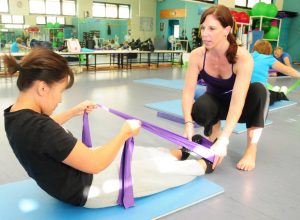Returning to exercise after the birth of your child
Postnatal Pilates is growing in popularity as a way to get back in shape after childbirth. With the added pressures on your time and your health that a new child brings, Pilates can offer a welcome relief. It is a controlled and scientific approach to exercise that can give you peace of mind. It is a great way to reduce your post-pregnancy paunch, re-strengthen your pelvic floor muscles and build up strength. For more information on the kind of exercise needed, go to Movement 101 site for podiatrist Sydney and find the exercise which is right for you.
So let’s look in more detail at how postnatal Pilates can help.

Postnatal Pilates
Postnatal Pilates – A fun way to get back in shape
Part of the reason that Pilates is so much fun is that it challenges you mentally as well as physically.
As opposed to just repetitively jogging on a treadmill or slogging it out on the stepper, you need to focus on the exercise. It is a very absorbing activity, and as such it allows you to completely escape your day to day concerns. It is a much welcome respite from the demands of parenthood.
Learning how to perform Pilates moves properly engages you. It also encourages you to focus on your breathing which has a very calming effect also. It is almost like a mild form of mindfulness and as such is a great de-stressor.
So don’t underestimate the psychological benefits of Pilates!
Some physiological benefits of postnatal Pilates
Not surprisingly, pregnancy can play havoc with your posture. It can cause the pelvis to be pulled forward leading to a phenomena known as anterior tilt.
This posture can endure long after the birth of your child and can lead to weakened abdominal muscles and tightened hip flexors.
In addition, whilst caring for your child, your posture can become increasingly compromised. Adopting a position where you rest your baby on one hip can throw out the natural alignment of your back.
Pilates teaches you to reconnect and strengthen pelvic floor muscles to help improve posture, core strength, and stability.
This has the added benefit of dealing with issues such as stress, incontinence and other problems that may have arisen such as a prolapse.
Pilates also puts a lot of emphasis on keeping the spine supple and correctly aligned. For obvious reasons, there is a great deal of pressure on the spine during pregnancy, and engaging in supervised rehabilitation at an early stage has great advantages.
Finally, many new participants are often surprised at how physically challenging Pilates can be. It is a real strength workout. It helps to restore muscle tone to areas that have often been neglected during pregnancy. This combined with the flexibility aspects of the sessions, allows your body to cope with the stresses and strains of handling your newborn.
A word of caution
Because of its popularity, Pilates is now taught widely. Be sure to use the guidance of reputable and qualified instructors with specific knowledge of postnatal exercise. Also, make sure you get clearance from your doctor or midwife before you start on a programme of Pilates classes.
So why not give postnatal Pilates a go? It’s fun, social and extremely beneficial.
We hope this information is useful for you. If you have any questions about our treatments, please contact us. You can find us in Mill Hill Broadway and Islington. If you like this blog, please share! We are always happy to help.



